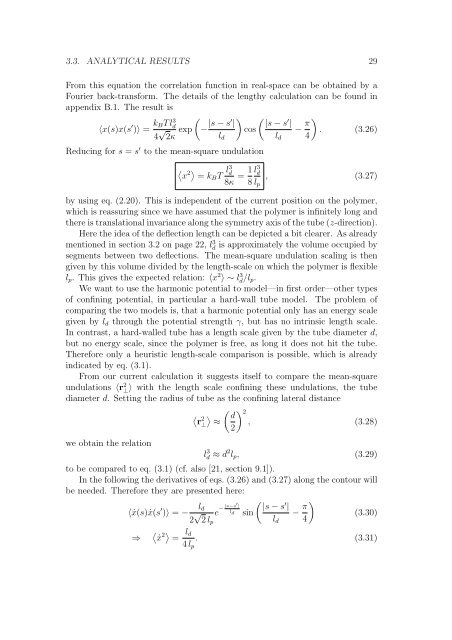Polymers in Confined Geometry.pdf
Polymers in Confined Geometry.pdf
Polymers in Confined Geometry.pdf
You also want an ePaper? Increase the reach of your titles
YUMPU automatically turns print PDFs into web optimized ePapers that Google loves.
3.3. ANALYTICAL RESULTS 29<br />
From this equation the correlation function <strong>in</strong> real-space can be obta<strong>in</strong>ed by a<br />
Fourier back-transform. The details of the lengthy calculation can be found <strong>in</strong><br />
appendix B.1. The result is<br />
〈x(s)x(s ′ )〉 = kBT l 3 d<br />
4 √ 2κ exp<br />
<br />
− |s − s′ |<br />
Reduc<strong>in</strong>g for s = s ′ to the mean-square undulation<br />
ld<br />
x 2 = kBT l3 d<br />
8κ<br />
′ |s − s |<br />
cos −<br />
ld<br />
π<br />
<br />
. (3.26)<br />
4<br />
1<br />
=<br />
8<br />
l 3 d<br />
lp<br />
, (3.27)<br />
by us<strong>in</strong>g eq. (2.20). This is <strong>in</strong>dependent of the current position on the polymer,<br />
which is reassur<strong>in</strong>g s<strong>in</strong>ce we have assumed that the polymer is <strong>in</strong>f<strong>in</strong>itely long and<br />
there is translational <strong>in</strong>variance along the symmetry axis of the tube (z-direction).<br />
Here the idea of the deflection length can be depicted a bit clearer. As already<br />
mentioned <strong>in</strong> section 3.2 on page 22, l3 d is approximately the volume occupied by<br />
segments between two deflections. The mean-square undulation scal<strong>in</strong>g is then<br />
given by this volume divided by the length-scale on which the polymer is flexible<br />
lp. This gives the expected relation: 〈x2 〉 ∼ l3 d /lp.<br />
We want to use the harmonic potential to model—<strong>in</strong> first order—other types<br />
of conf<strong>in</strong><strong>in</strong>g potential, <strong>in</strong> particular a hard-wall tube model. The problem of<br />
compar<strong>in</strong>g the two models is, that a harmonic potential only has an energy scale<br />
given by ld through the potential strength γ, but has no <strong>in</strong>tr<strong>in</strong>sic length scale.<br />
In contrast, a hard-walled tube has a length scale given by the tube diameter d,<br />
but no energy scale, s<strong>in</strong>ce the polymer is free, as long it does not hit the tube.<br />
Therefore only a heuristic length-scale comparison is possible, which is already<br />
<strong>in</strong>dicated by eq. (3.1).<br />
From our current calculation it suggests itself to compare the mean-square<br />
undulations 〈r2 ⊥ 〉 with the length scale conf<strong>in</strong><strong>in</strong>g these undulations, the tube<br />
diameter d. Sett<strong>in</strong>g the radius of tube as the conf<strong>in</strong><strong>in</strong>g lateral distance<br />
2 2 d<br />
r⊥ ≈ , (3.28)<br />
2<br />
we obta<strong>in</strong> the relation<br />
l 3 d ≈ d 2 lp, (3.29)<br />
to be compared to eq. (3.1) (cf. also [21, section 9.1]).<br />
In the follow<strong>in</strong>g the derivatives of eqs. (3.26) and (3.27) along the contour will<br />
be needed. Therefore they are presented here:<br />
〈 ˙x(s) ˙x(s ′ )〉 = − ld<br />
2 √ e<br />
2 lp<br />
− |s−s′ |<br />
ld s<strong>in</strong><br />
|s − s ′ |<br />
ld<br />
− π<br />
<br />
4<br />
(3.30)<br />
⇒ ˙x 2 = ld<br />
. (3.31)<br />
4 lp













